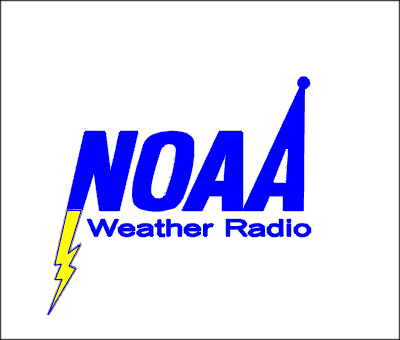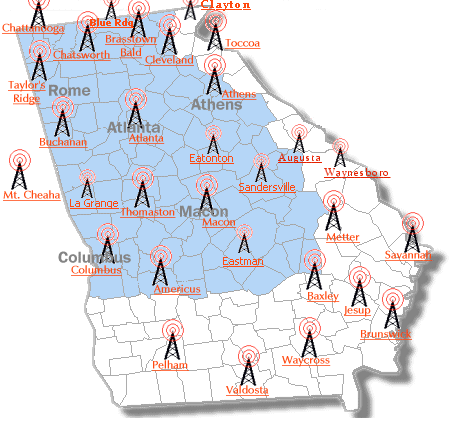|
|
,
NOAA Weather Radio All Hazards
 The National Weather Service in Peachtree City now provides programming
for 16 transmitters on seven frequencies across North and Central Georgia.
However, Georgia's NOAA Weather Radio
Network (for the entire state) consists of more than 2 dozen
transmitters scattered from near the Florida border to the mountains in
extreme north Georgia.
The National Weather Service in Peachtree City now provides programming
for 16 transmitters on seven frequencies across North and Central Georgia.
However, Georgia's NOAA Weather Radio
Network (for the entire state) consists of more than 2 dozen
transmitters scattered from near the Florida border to the mountains in
extreme north Georgia.
Broadcasts of weather information - including warnings - can be heard 24 hours
a day in practically every community in the state. In fact, some communities can hear weather
broadcasts from more than one radio station. This can be advantageous. Or it can lead to
problems. For this reason it is important to know enough about the broadcast system to make a choice of
transmitter that will give you the most protection.
 Each transmitter emits an alert tone when warnings or other important weather messages are broadcast
for the first time. However, no transmitter sends out the alert tones for all counties. Each tower
sends the tones to a designated set of counties known as the "official service area" for that tower.
The official service area is determined by a tower's ability to get a signal of sufficient
strength into each county. If you want to be alerted,
you will need to be sure you are tuned to a transmitter that has your county in its official service area.
This is easy to do. Go to the network map and pass your
cursor over, or click on, any broadcast tower. Information for programming special receivers using
"SAME" technology is included with that map.
Each transmitter emits an alert tone when warnings or other important weather messages are broadcast
for the first time. However, no transmitter sends out the alert tones for all counties. Each tower
sends the tones to a designated set of counties known as the "official service area" for that tower.
The official service area is determined by a tower's ability to get a signal of sufficient
strength into each county. If you want to be alerted,
you will need to be sure you are tuned to a transmitter that has your county in its official service area.
This is easy to do. Go to the network map and pass your
cursor over, or click on, any broadcast tower. Information for programming special receivers using
"SAME" technology is included with that map.
For non-weather emergencies, NWS activates the system at the
request of local and/or state officials.
The NWS does not initiate the contact or the message. Local or state officials provide text
information about the non-weather hazard directly to the local NWS offices. NWS offices
set up agreements to speed the process, since minutes make a difference. In most areas,
the local or state Office of Emergency Management or Preparedness, civil defense, police
or mayor/commissioner sets up linkages to send messages on systems such as the EAS and NWR.
Non-weather emergency messages include:
- technological accidents (e.g., chemical release, oil spill, nuclear power
plant emergencies, maritime accidents, train derailments)
- Amber (Child abduction) alerts
- terrorist attacks
These non-weather emergency messages will be broadcast over NWR when: (1) public
safety is involved, (2) the message comes from an official government source, and (3)
time is critical.
SPECIAL NOTICE !
There are 3 pairs of transmitters that broadcast
identical information - including the SAME alert tones. The pairings are:
If you are in the official service area of one of these towers, be aware that you may be able to
receive good quality audio and the correct SAME alert tones from the other paired tower's frequency
despite being outside that tower's "official service area".
|
|
Frequently Asked Questions about NOAA Weather Radio
 Back to home page Back to home page
|



 Back to home page
Back to home page